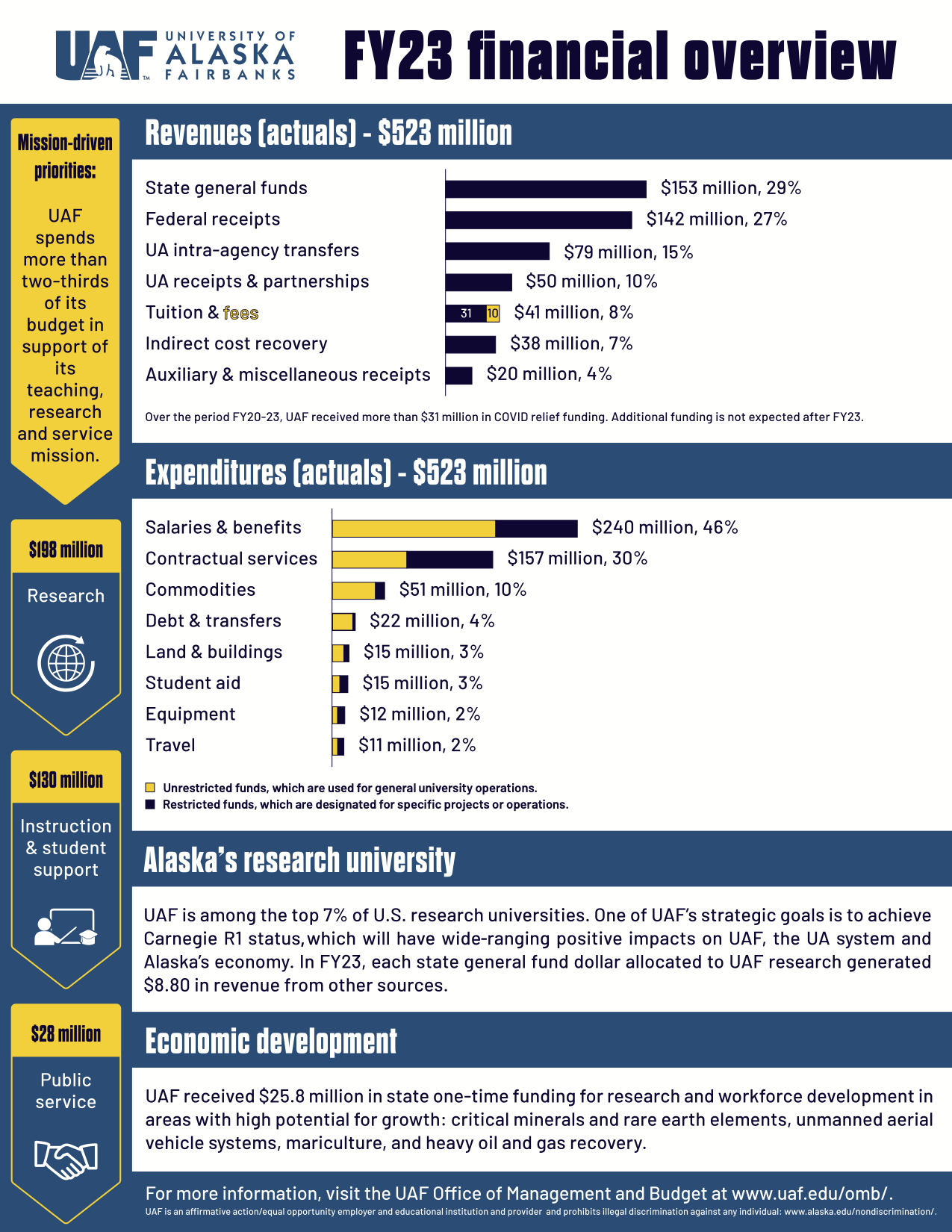FY23 Budget
On June 28, 2022, Governor Dunleavy released the State of Alaska FY23 budget, marking the completion of the state appropriations process and the first operating and capital budget increases since prior to FY20.
UAF’s FY23 financial position improved with the following funding increments:
Base Operating Budget
- $3.7 million for some fixed costs and fund-1 staff compensation increases, effective in July 2022. Funding for faculty compensation increases will continue to be pursued through ongoing confidential negotiations.
- $2.0 million for Alternative Energy research funds through the Alaska Center for Energy and Power (ACEP).
- $500 thousand for Teacher Education funding for practicums and degree completion.
Economic Development, one-time funding
One-time funding in the Governor’s budget was directed to UAF for economic development areas that have a connection to the state economy with high potential for growth:
- $5.8 million – Critical Minerals and Rare Earth Elements Research and Development
- $10.0 million – Unmanned Aerial Vehicle Systems (Drone Program)
- $5.0 million – Mariculture Research and Development
- $5.0 million – Heavy Oil and Gas Recovery Research and Development
Overall, UAF received a $32 million operating budget increase (or 23.4 percent) over the FY22 state allocation through a mix of one-time and on-going base funding. We look forward to the coming year and the opportunities the additional funding will afford us as we continue to grow our research, academic programs, and increase student recruitment and retention.
Capital budget
Fortunately, UAF’s most significant deferred maintenance (DM) request for Moore and Bartlett plumbing and revitalization is included at $23 million.
The capital budget also includes $2.5 million for emerging energy opportunities through ACEP, $500,000 for Rare Earth Demonstration Facility, $250,000 for Rare Earth Mineral Security and a portion of $2 million for Fisheries, Seafood and Maritime Works to be determined through a UA-wide process.
In addition, all universities will also participate in an upgrade of our student information technology systems ($20 million) affecting how we deliver education and communicate with students throughout Alaska and beyond. This project will improve the student experience and is critical to meeting changing student and technology needs.
Technical Vocational Education Program (TVEP)
TVEP funding support will have system-wide impact and will support UA workforce programs, as well as needed receipt authority that will allow UAF to receive a competitive grant, if awarded, to support Sikuliaq operations and construction of a new dock at the Seward Marine Center. This support of workforce, economic development and research demonstrates a commitment to new opportunities for UAF and Alaska.
Single appropriation
The State of Alaska Legislature moved the UA system back to a single appropriation, which allows us to more efficiently manage operations between the universities and the UA System Office. This is beneficial in many ways and will allow us to be nimble and proactive when using our resources, or to support shared expenses where economies of scale exist.
FY23 UA BOR Approved Operating and Capital Budgets - Yellowbook
FY23 BOR Approved Operating Budget Request
The FY23 UA proposed budget request is $280.7 million, an increase of 2.9 percent
from the FY22 level of $272.7 million. This represents a stable base level of state
funding that includes modest increases to accommodate inflation.
FY23 BOR Approved Capital Budget Request
The BOR approved capital budget request includes $50 million for UA deferred maintenance
(UAF portion is approximately $31.1 million, if funded). The UA System FY23 capital
budget request also includes $20 million for student information technology (IT) modernization
and security upgrades.
Investment Areas for Economic Development
Separate from the State funding request, UA is requesting $31.5 million for priority
areas that can positively impact the state’s economy. These areas include:
- Critical Minerals and Rare Earths Elements Research and Development
- Unmanned Aerial Vehicle Systems
- Fisheries, Mariculture and Maritime
- Health Workforce, Biomedical Research and Food Security
- Alternate Energy
- Oil and Gas Recovery
The Governor will release the FY23 budget in December 2021 and the legislative session will run from January through April 2022, although in recent years, the session has ended later than April.
UA and UAF developed the FY23 operating budget plan with a focus on progress toward budget stability by utilizing the following initial guidelines:
- Priorities that fit with the Board of Regents’ (BOR) goals and measures, including focus on a reduced fixed-cost base, promoting student enrollment, and benefit to the Alaska economy
- Providing stability to the UA budget, including key investments for economic return
- A compensation strategy necessary to attract and retain quality employees
- Modernizing the student technology experience
- Increased earned revenue and partnership opportunities
- Capital funding for deferred maintenance and renewal projects
- The state funding environment



